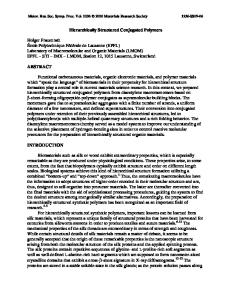Conjugated polymers for thin film coating process
- PDF / 14,238,804 Bytes
- 9 Pages / 612 x 792 pts (letter) Page_size
- 102 Downloads / 470 Views
Conjugated polymers for thin film coating process Zhexiong Tang, Wenguang Li, Cheryl Nowak, and Sze Yang Department of Chemistry, University of Rhode Island, Kingston, RI 02879
ABSTRACT In this paper, we present the syntheses of the conjugated polymers of different “effective molecular weights.” The goal is to be able to optimize the thin film coating process without compromising the electronic, optical and electroactive properties. Our strategy for controlling the effective molecular weight is to synthesize a double-strand conducting polymer that is an inter-polymer complex of a polymeric dopant and a conjugated polymer. The first strand of the two-strand complex is either a polyaniline or a polypyrrole chain, while the second strand is a poly(acrylic acid). The molecular weight of poly(acrylic acid) is used as a parameter for adjusting the coating and film-forming properties. We found that the inter-polymer complexes are dispersible in water. The dispersion stability is strongly dependent on the molecular weight of the poly(acrylic acid) strand. The dispersion is more stable for polymers synthesized with higher molecular weight of poly(acrylic acid). We also found that the particle size and particle morphology are dependent on the effective molecular weight.
INTRODUCTION Conjugated polymers are used in light emitting diodes, thin film transistors, electrochromic devices, chemical sensors, and anticorrosion coatings. A key element in these devices is a thin layer of π-conjugated polymer. This thin film is coated on a substrate and is part of a multi-layer structure in the device. For the device to perform, the thin film should have good mechanical property. The coated thin film needs to be adherent to the substrate, and the polymer needs to be elastic enough to maintain a stable interface between the contacting layers of the devices. For traditional organic coatings, the molecular weight (MW) of the polymer is an important parameter for optimizing both the coating process and the thin film mechanical properties. High molecular weight is often needed for adhesion to the substrate, for the elasticity of the polymer film, for optimizing the coating process, and for a good filmformation property. Molecular weight has not been studied as a parameter to optimize the thin film coating process of the π-conjugated polymer because of the difficulty in controlling and measuring its molecular weight. This difficulty is understandable given the complexity of the polymerization process of the conjugated polymers. Although the required conjugation length for optical and electronic properties can be satisfied at relatively low molecular weight, a good film forming property usually requires a much higher molecular weight. BB7.4.1
In this article, we report an approach that controls the “effective molecular weight” for the conjugated polymer for coating process. The idea involves the use of an inter-polymer complex of conducting polymer. This molecular complex consists of two polymers that form a double-strand molecular complex
Data Loading...











